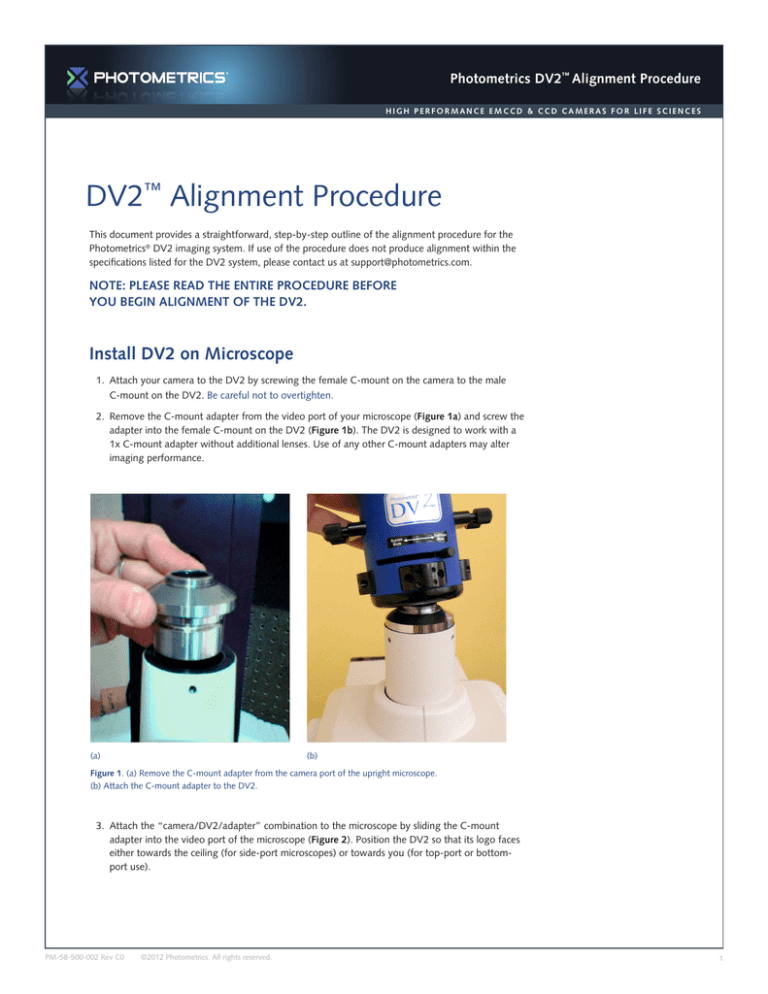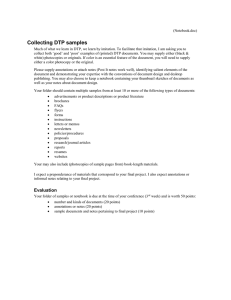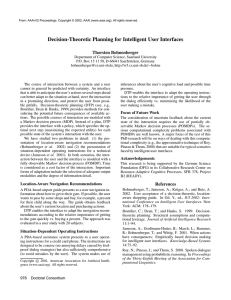
Photometrics DV2™ Alignment Procedure
HIGH PERFORMANCE EMCCD & CCD CAMERAS FOR LIFE SCIENCES
DV2™ Alignment Procedure
This document provides a straightforward, step-by-step outline of the alignment procedure for the
Photometrics® DV2 imaging system. If use of the procedure does not produce alignment within the
specifications listed for the DV2 system, please contact us at support@photometrics.com.
NOTE: PLEASE READ THE ENTIRE PROCEDURE BEFORE
YOU BEGIN ALIGNMENT OF THE DV2.
Install DV2 on Microscope
1. Attach your camera to the DV2 by screwing the female C-mount on the camera to the male
C-mount on the DV2. Be careful not to overtighten.
2. Remove the C-mount adapter from the video port of your microscope (Figure 1a) and screw the
adapter into the female C-mount on the DV2 (Figure 1b). The DV2 is designed to work with a
1x C-mount adapter without additional lenses. Use of any other C-mount adapters may alter
imaging performance.
(a)
(b)
Figure 1. (a) Remove the C-mount adapter from the camera port of the upright microscope.
(b) Attach the C-mount adapter to the DV2.
3. Attach the “camera/DV2/adapter” combination to the microscope by sliding the C-mount
adapter into the video port of the microscope (Figure 2). Position the DV2 so that its logo faces
either towards the ceiling (for side-port microscopes) or towards you (for top-port or bottomport use).
PM-58-500-002 Rev C0
©2012 Photometrics. All rights reserved.
1
Two-Channel, Simultaneous-Imaging System
Photometrics DV2™ Alignment Procedure
Figure 2. The DV2/camera combination mounted on the top port of the microscope.
Before starting alignment:
1. Make sure there are no sample slides in place on the microscope.
2. Turn on (only) the brightfield/transmitted light on the microscope. Do not use fluorescence.
3. Make sure there are no microscope filter cubes in the light path of the microscope.
4. Make sure you are using an objective with a magnification of at least 40x.
5. Make sure the objective is of the PlanApo variety and that there is no phase
ring in the objective.
6. Pull the DV2 filter slide halfway out of the tube, i.e., Bypass Mode (Figure 3).
7. The slider lever should stay in Dual-View Mode (Figure 4).
Filter cube in
Bypass Mode
Figure 3. The DV2 with the filter cube in Bypass Mode.
PM-58-500-002 Rev C0
©2012 Photometrics. All rights reserved.
2
Two-Channel, Simultaneous-Imaging System
Photometrics DV2™ Alignment Procedure
Slider lever
Figure 4. The DV2 with the slider lever in Dual-View Mode.
8. The microscope should be set to direct the image to the camera, not to the eyepieces.
9. Using the software of your choice, display a live, full-resolution image on your
computer screen.
a. The region of interest should be the “full chip”.
b. Make sure you are not binning.
c. Make sure you do not have “auto-scaling” of the display turned on.
6-Step Alignment Procedure
The alignment of the DV2 is performed using a 6-step process:
1. Positioning and aligning CCD mask
2. Orientation and centration of the front aperture
3. Right/left positioning of images
4. Insertion and orientation of the calibration grid
5. Up/down positioning of images
6. Fine alignment using software feedback
Step 1: Positioning and aligning CCD mask:
1. When the camera is acquiring, you should see an image with one white or grey area in
between two black areas. The black areas indicate where light is blocked from reaching
the camera. The white or grey area indicates where light is reaching the camera. This
white or grey area is an image of the internal DV2 aperture mask. If the area is white,
you may be saturating the camera. Please lower the intensity of the brightfield light until
the white area becomes a light grey color.
2. The light area of the image may appear rotated if the camera and the DV2 are not
rotated correctly in respect to each other (Figures 5a and 5b). When both systems are
properly rotated, the edges of the aperture will be parallel to the edges of the camera
chip (Figure 5c) and the internal aperture in the DV2 will appear straight up and down.
PM-58-500-002 Rev C0
©2012 Photometrics. All rights reserved.
3
Photometrics DV2™ Alignment Procedure
Two-Channel, Simultaneous-Imaging System
(a)
(b)
(c)
Figure 5. (a, b) Images of the DV2 aperture show that the aperture and camera are not aligned with each
other. (c) Aperture edges are vertical when the camera is properly aligned to the DV2.
3. The DV2 is supplied with a C-mount adapter that can rotate independently from the rest of
the DV2 body. This allows you to properly orient the aperture mask in the DV2 in respect
to the camera. The screw that allows you to lock and unlock the DV2 C-mount adapter is
located in a recessed hole labeled with the words camera lock found at the top of the DV2
(Figure 6).
C-mount adapter rotates
Camera lock
Figure 6. The camera lock on the DV2 can be unlocked to rotate the C-mount adapter.
4. Using the 0.05" Allen tool (ball driver) that is supplied with the system, loosen the camera
lock screw to unlock the DV2 C-mount adapter. Once this is unlocked, you will be able to
rotate the DV2 C-mount adapter with the camera attached.
5. Rotate the DV2 C-mount adapter, along with the camera, clockwise or counterclockwise
in respect to the DV2 body until the edges of the light grey area in the image are exactly
vertical (Figure 5c).
6. Once the aperture edges are exactly vertical, tighten the camera lock screw to lock
the C-mount adapter on the DV2.
7. Slide DV2 slider to Bypass Mode
PM-58-500-002 Rev C0
©2012 Photometrics. All rights reserved.
4
Photometrics DV2™ Alignment Procedure
Two-Channel, Simultaneous-Imaging System
8. The DV2 is equipped with four CCD aperture blades, one for each side of the chip.
The position of this mask is adjusted with the lower set of 0.05" hex screws on each of
the four aperture adjustment panels on the DV2.
CCD aperture adjustment
Front
DV2 aperture adjustment
DV2 aperture adjustment
CCD aperture adjustment
CCD aperture adjustment
Right
Left
CCD aperture adjustment
Back
Figure 7. Aperture adjustment panels.
9. Place the system in Bypass Mode and have the camera displaying a live preview image.
Starting with the “front” aperture adjustment panel (Figure 7) use the supplied 0.05"
Allen tool and the CCD aperture adjustment screws to adjust the position of the front CCD
aperture blade so that it is just at the top of the field of view and then adjust it so it is just
out of the field.
a. Each CCD adjustment blade has two adjustment screws. One that adjusts the left half of
the blade and one that adjusts the right half.
b. To adjust the position of the blade, adjust one half first and then the other half, thus
“walking” the blade into the desired position.
c. Once the position of the blade is close to the desired position, the precise angle of the
blade can be adjusted by turning one or the other adjustment screws slightly until the
desired angle is reached
10. Repeat these adjustments for right, left and back CCD aperture blades.
DO NOT OPEN THE CCD APERTURE BLADE BEYOND THE EDGE OF THE
CAMERA BEING USED.
Step 2: Orientation and centration of the DV2 aperture:
1. Move DV2 slider to Dual-View Mode. Leave filter cube in Bypass Mode.
2. Now use the aperture screws on the left and right aperture adjustment panels (Figure 7)
to adjust the location of the aperture edges. The procedure to adjust these aperturess is
identical to the adjustment of the CCD aperture blade described above. It is very important
that you take the time to execute this step in a highly precise manner. Adjust the left edge
of the aperture until it is located at ¼ of the width of the image. Adjust the right edge of
the aperture until it is located at ¾ width of the image. If, for example, your detector has a
width of 1392 pixels, then the left edge of the aperture should be positioned at pixel 348
and the right edge of the aperture should be positioned at pixel 1044. The resultant image
will look like Figure 8.
PM-58-500-002 Rev C0
©2012 Photometrics. All rights reserved.
5
Photometrics DV2™ Alignment Procedure
Two-Channel, Simultaneous-Imaging System
Left aperture at ¼ W
Right aperture at ¾ W
Full width (W)
Figure 8. Image of the aperture mask centered on the camera and set to the correct width.
Step 3: Right/left positioning of images
With the completion of Step 2, the internal aperture of the DV2 has been centered in respect
to the camera attached on the back. Step 3 ensures that the right/left position of the images on
the camera is correct.
1. Keep the slider lever in Dual-View Mode (Figure 4).
2. Push the DV2 filter holder all the way into the DV2 tube.
3. You should now see two white or grey stripes in the image field. If you do not see anything,
or if the stripes look very dim, increase the intensity of the brightfield light until the images
are visible on the computer screen. Each stripe will usually be a different grey level.
4. Since the images are not yet aligned, the view on the computer screen may look
like Figures 9a or 9b. If the image on the screen shows a bright stripe in the middle
(Figure 9a), then the two images are overlapping in this region of the camera. The left
image needs to move to the left and the right image needs to move to the right. If the
images show a black stripe in the middle (Figure 9b), then the images are too far apart.
The right image needs to move to the left and the left image needs to move to the right.
Move left
image to
the left.
Move left
image to
the right.
Move right
image to
the right.
(a)
Move right
image to
the left.
(b)
Figure 9. Images not positioned properly in the horizontal direction. (a) Images overlapping in the center
(too close together). (b) Images too far apart (black gap between images).
PM-58-500-002 Rev C0
©2012 Photometrics. All rights reserved.
6
Two-Channel, Simultaneous-Imaging System
Photometrics DV2™ Alignment Procedure
5. Using the R/L knobs only, move each grey stripe left or right until you do not see any black
stripes in the image and there is no overlap (bright stripe) in the center (Figure 10).
Figure 10. Images positioned properly in the horizontal direction using the R/L knobs
(no gap or overlap in the center).
Step 4: Insertion and orientation of the calibration grid
With the completion of Step 3, the images have been properly positioned in the right and
left directions. The next alignment step will properly orient the calibration grid provided with the
system.
1. Remove the calibration grid supplied with the system from its case. The grid is a glass
substrate that has a metallic coating on one side of the substrate. Please note which side
has the coating.
2. The objective you will be using will normally require a coverslip of the appropriate
thickness. Please place a coverslip on top of the coating side of the grid and tape it to the
grid. If the objective you are using is an immersion objective, please make sure to use the
appropriate immersion liquid when doing this alignment.
3. Always place the grid on your microscope stage with the coating/coverslip facing the
objective. If the grid is not placed in the proper orientation, you will not be able to produce
a focused image of the grid.
4. Make sure the slider lever is in Dual-View Mode (Figure 4).
5. The DV2 filter holder should be in Bypass Mode (halfway out of the tube, Figure 3).
6. Adjust the microscope focus until the image of the grid is in focus on the computer screen.
You should see one image of the grid in the exact center of the image field. An example is
shown in Figure 11.
Figure 11. Image of the grid in the center of the image field. You can see that the grid is rotated
because the lines are not horizontal and vertical.
PM-58-500-002 Rev C0
©2012 Photometrics. All rights reserved.
7
Photometrics DV2™ Alignment Procedure
Two-Channel, Simultaneous-Imaging System
7. If the lines of the grid are not horizontal and vertical, then proceed as follows:
a. If your microscope stage has rotation adjustments, rotate the grid until the lines are
horizontal and vertical in the image (Figure 12).
b. If your microscope stage does not have rotation adjustments, loosen the screws of the
microscope C-mount adapter and rotate the microscope C-mount adapter with the DV2
attached until the lines are horizontal and vertical (Figure 12).
Figure 12. Image of the grid in the center of the image field. You can see that the grid is properly oriented
because the lines are horizontal and vertical.
8. Move the microscope stage until you can see an edge of the grid either at the bottom
(Figure 13a) or top (Figure 13b) of the image field.
Grid edge
(a)
(b)
Figure 13. Image of the grid with an edge of the grid in the field of view. (a) Grid edge visible on bottom.
(b) Grid edge visible on top.
Step 5: Up/down positioning of images
The completion of Step 4 oriented the grid properly in respect to the microscope and
DV2. Now you are ready to position the images correctly in the up/down position.
Before beginning this step, it is important to realize that the images will rotate as they are
moved up and down. Figures 14a-e show how this rotation takes place.
• When the left image is moved up, it will rotate clockwise.
• When the right image is moved up, it will rotate counterclockwise. • When the left image is moved down, it will rotate counterclockwise.
• When the right image is moved down, it will rotate clockwise.
• When the up/down positions of both images are correct, there will be no rotation
between the images.
PM-58-500-002 Rev C0
©2012 Photometrics. All rights reserved.
8
Photometrics DV2™ Alignment Procedure
Two-Channel, Simultaneous-Imaging System
Figure 14a
Figure 14b
As the images are
moved up, their tops
rotate inward, towards
each other.
Figure 14c
Images in ideal
up/down position
As the images are moved
down, their bottoms
rotate inward, towards
each other.
Figure 14d
Figure 14e
PM-58-500-002 Rev C0
©2012 Photometrics. All rights reserved.
9
Photometrics DV2™ Alignment Procedure
Two-Channel, Simultaneous-Imaging System
1. Place your mouse pointer on one of the horizontal lines in the image, as far to the left
in the image as possible (Figure 15). Be very careful not to touch or move the mouse;
you will be using its position as a reference point.
Place mouse
pointer here.
Figure 15. Image of the grid with an edge of the grid in the field of view and the cursor placed at the left
edge of the image on the thinnest line.
2. Push the DV2 filter holder all the way into the DV2 tube. You should now see two
images of the grid, one on the left and one on the right (Figure 16). Note that you may
have to increase the intensity of the brightfield light to see these two images. One image
will usually be brighter than the other image due to the different bandpasses of the
emission filters.
Thinnest line is
above the mouse
pointer reference.
Mouse pointer
reference
Figure 16. Images of the grid (DV2 Mode) with an edge of the grid in the field of view.
The left image is too high in respect to the reference point.
3. Look only at the image on the left. Using the mouse pointer as your reference, check to
see if this image is too far up or too far down (compared to the previous image). Use the
U/D knob that controls the left image to move the image either up or down until it is in the
proper position (according to the mouse pointer). In the example above, the left image has
to be moved down in order to make the thinnest line coincident with the mouse pointer.
After adjusting the image, it will look like Figure 17.
PM-58-500-002 Rev C0
©2012 Photometrics. All rights reserved.
10
Photometrics DV2™ Alignment Procedure
Two-Channel, Simultaneous-Imaging System
Thinnest line is
coincident with
mouse pointer
reference.
Mouse pointer
reference
Figure 16. Images of the grid (DV2 Mode) with an edge of the grid in the field of view.
The left image is now coincident with the reference point.
4. Pull the DV2 filter holder halfway out of the DV2 tube (Bypass Mode) so that you once
again see only one image of the grid in the center of the image field (Figure 18). You may
need to decrease the level of the brightfield to be able to see this single image
of the grid.
Place mouse
pointer here.
Figure 18. Image of the grid with an edge of the grid in the field of view and the cursor placed at the right
edge of the image on the thinnest line.
5. Keeping the mouse pointer on the same horizontal line in the image, move it as far to the
right in the image as possible (Figure 18). Be very careful not to touch or move the mouse;
you will be using its position as a reference point.
6. Insert the DV2 filter holder all the way into the DV2 tube. Now look only at the image
on the right. Using the mouse pointer as your reference, check to see if this image is too
far up or too far down (Figure 19) compared to the previous image. Use the U/D knob
that controls the right image to move the image either up or down until it is in the proper
position (according to the mouse pointer).
Thinnest line is
above mouse
pointer reference.
Mouse pointer
reference
Figure 19. Images of the grid (DV2 Mode) with an edge of the grid in the field of view.
The right image is too high in respect to the reference point.
PM-58-500-002 Rev C0
©2012 Photometrics. All rights reserved.
11
Photometrics DV2™ Alignment Procedure
Two-Channel, Simultaneous-Imaging System
7. After moving the right image down to the correct position (Figure 20), you are within a few
pixels of having the two DV2 images aligned and registered to each other.
Thinnest line is
coincident with
mouse pointer
reference.
Mouse pointer
reference
Figure 20. Images of the grid (DV2 Mode) with an edge of the grid in the field of view.
The right image is now coincident with the reference point.
Step 6: Fine alignment using software feedback:
To align the two images to each other to within a few pixels, you will need to use your
software’s alignment module. This module has been specially written to work with the DV2.
It will allow you to subtract the two DV2 images and display the resulting subtracted image
live to the computer screen while you fine-tune the R/L and U/D knobs on the DV2.
The DV2 optics produce images that can be aligned to each other at a subpixel level. The most
misalignment you will see will be on the order of 1/4 to 1/2 of a pixel in the extreme corners of
the image.
1. Using the special alignment module in the software, view a live subtracted image.
2. Adjust the images’ right/left positions first. For now, ignore any up/down-related
misregistration. Using only the R/L knobs, fine-tune the right/left alignment of the images
until they are as precisely aligned as possible.
3. It is important to remember that when you move the images up and down using the U/D
knobs, the images move up and down on an arc, as discussed previously (Figures 14a-e).
Therefore, if you do not position the two images in their proper up/down positions, they
will be rotated relative to each other. There is an “ideal” up/down position in which there
will be no rotation between the images.
4. Use only the U/D knobs and fine-tune the up/down positions of the images until they
are precisely aligned. If there appears to be some rotation between the two images, you
will need to move both images up together at the same time (by a slight amount) and see
if the rotation improves. If it does not improve, then move both images down together
(by a slight amount) to improve the rotation.
5. On days that you require full-field imaging (i.e., when you do not want to use the
DV2 for split-field imaging), you do not have to remove the DV2 from your setup.
Instead, you will use the DV2 in its Bypass Mode. To do so, you simply need to have:
a. The slider lever in the Bypass Mode position
b. The DV2 filter holder in the Bypass Mode position (halfway out of the tube)
USA 520.889.9933
Asia Pacific +65.6841.2094
PM-58-500-002 Rev C0
France +33.1.60.86.03.65
Germany +49.89.660.779.3
©2012 Photometrics. All rights reserved.
Japan +81.3.5639.2731
UK +44.1628.890858
www.photometrics.com
info@photometrics.com
12




